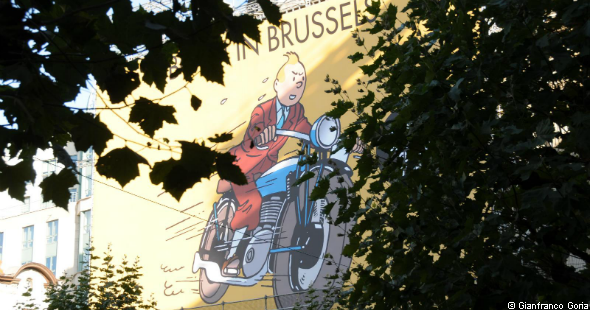Culture, Literature
The Last Native Belgian: Tintin in Brussels
When I arrived in Brussels for a two-month stay in January, I exited the train with my family to be greeted by an enormous mural of a scene from Hergé’s Tintin in the Land of the Soviets. Nearby was another mural, this one in color, of Tintin and his famous canine sidekick Snowy walking through a mid-century European train station. Heading through the streets to our apartment, it soon became apparent that Tintin is not only Brussels’ most famous fictional resident—his visage is everywhere, and public artwork also features other Hergé characters such as Quick & Flupke covering entire brick buildings. In our neighborhood, he seemed to be the last native Belgian. Everyone else appeared to be Arabic.
Georges “Hergé” Remi’s twenty-four Tintin albums have made his creator uncancellable, despite the fact that Remi faced fierce criticism for continuing to publish his comic strips during the German occupation in the Nazi-controlled newspaper Le Soir, although no charges were ever brought against him. Remi’s albums are a glimpse of the lost world of the 20th century—revolutions, kings, colonies, and banana republics, with impeccably rendered cars, buildings, and historical backdrops. The albums show Europe in between the wars—or perhaps before the wars. Peter Hitchens noted recently that he, like so many other journalists, enjoys “rereading old volumes of Tintin, another fantasy reporter in an uncomplicated, beautifully-drawn, old-fashioned world.”
Indeed, if anything, Remi’s work has become more famous in the past decades. His merchandise—primarily produced by Moulinsart, most of it enormously expensive—can be found anywhere from the comic bookshops of Montreal to the famous Moroccan marketplaces of Marrakech, where I found hand-carved wooden busts of the boy reporter. (The Moroccans claim that Tintin visited their souks in The Crab with the Golden Claws and go to great lengths to prove it.) Although Tintin in the Congo (1931) is considered a racist and colonial depiction of Africans and has only recently been republished in English (replete with a careful “Collector’s Edition” label lest anyone think it was being purchased for reading purposes), it is wildly popular in Africa. On a trip to West Africa some years ago, I found posters of the offending cover for sale everywhere.
Perusing the wares of the Bouquinistes of Paris along the Seine, virtually every bookseller had a stock of Tintin albums and posters, including one of Tintin in the Tour de France. In Brussels, Hergé artwork is on everything from stamps to keychains in shop windows in the Grote Markt; one store features Tintin figurines with prices running to 1,500 euros. Nearly every frame of every album has been merchandised, and it obviously sells. Our apartment was just down the street from the Place du Jeu de Balle, which has hosted a famous daily flea market for 150 years, packed with sellers of trash and treasures. Tintin memorabilia is strewn throughout—toys, pins, albums, and stacks of ancient Tintin magazines, which ran from 1946 to 1993 and featured some of the best comic art in Europe. It looks much like the flea market in The Secret of the Unicorn. My children faithfully combed through the piles in search of their favorite characters.
Remi was not a Christian, but his work was rooted in a culturally Christian context. The 1947 Christmas cover of Tintin magazine, for example, depicts Tintin, Captain Haddock, and their friends walking down a wintry country path through a starry night towards a dark church with golden windows. The 1948 Christmas cover showed Tintin and his friends kneeling before a Nativity scene much like the enormous one that is still constructed in the Grote Markt each year. Another Christmas picture shows Tintin, holding a lantern and a Bible, treading through the snow towards church, a bright star gleaming over the steeple. Tintin was a character of his time and place, although LGBT activists have tried to cash in on his popularity by claiming, predictably, that he was gay.
READ THE REST OF THIS COLUMN AT THE EUROPEAN CONSERVATIVE








